文章目录
- 一、网络最大流问题
- 二、Ford-Fulkerson 算法(最坏时间复杂度:O(f×m))
- 2.1 残存网络
- 2.2 增广路径
- 2.3 算法介绍
- 2.4 完整代码
- 三、Edmons-Karp 算法(最坏时间复杂度:O(m×m×n))
- 3.1 算法介绍
- 3.2 完整代码
- 四、Dinic 算法(最坏时间复杂度:O(m×n×n))
- 4.1 Level Graph
- 4.2 算法介绍
- 4.3 完整代码
- 五、三种算法的性能测试
- 5.1 测试1
- 5.2 测试2
- 5.3 测试部分完整代码
- 5.4 结论(仅供参考)
标题中时间复杂度用到的符号说明:f 代表最大流的大小,m代表边的数量,n 代表节点的数量
本博客学习自:B站-ShusenWang
一、网络最大流问题
最大流问题,是网络流理论研究的一个基本问题,求网络中一个可行流 ,使其流量
达到最大, 这种流
称为最大流,这个问题称为 (网络)最大流问题。
最大流问题是一个特殊的线性规划问题,就是在容量网络中,寻找流量最大的可行流。
下面我们用一个例子来直观理解网络最大流问题
如下图所示,S处是一个水源,图中的弧是水管,管道由于材质、直径的不同,其所能承受的输水量也不同,所以就出现了下图所示的不同数值的弧,我们的目标是将水源从 S 通过管道运输到 T 点,且在满足管道能承受的输水量的前提下尽可能使得输送到 T 点的水最大化。
这就是最大流问题。
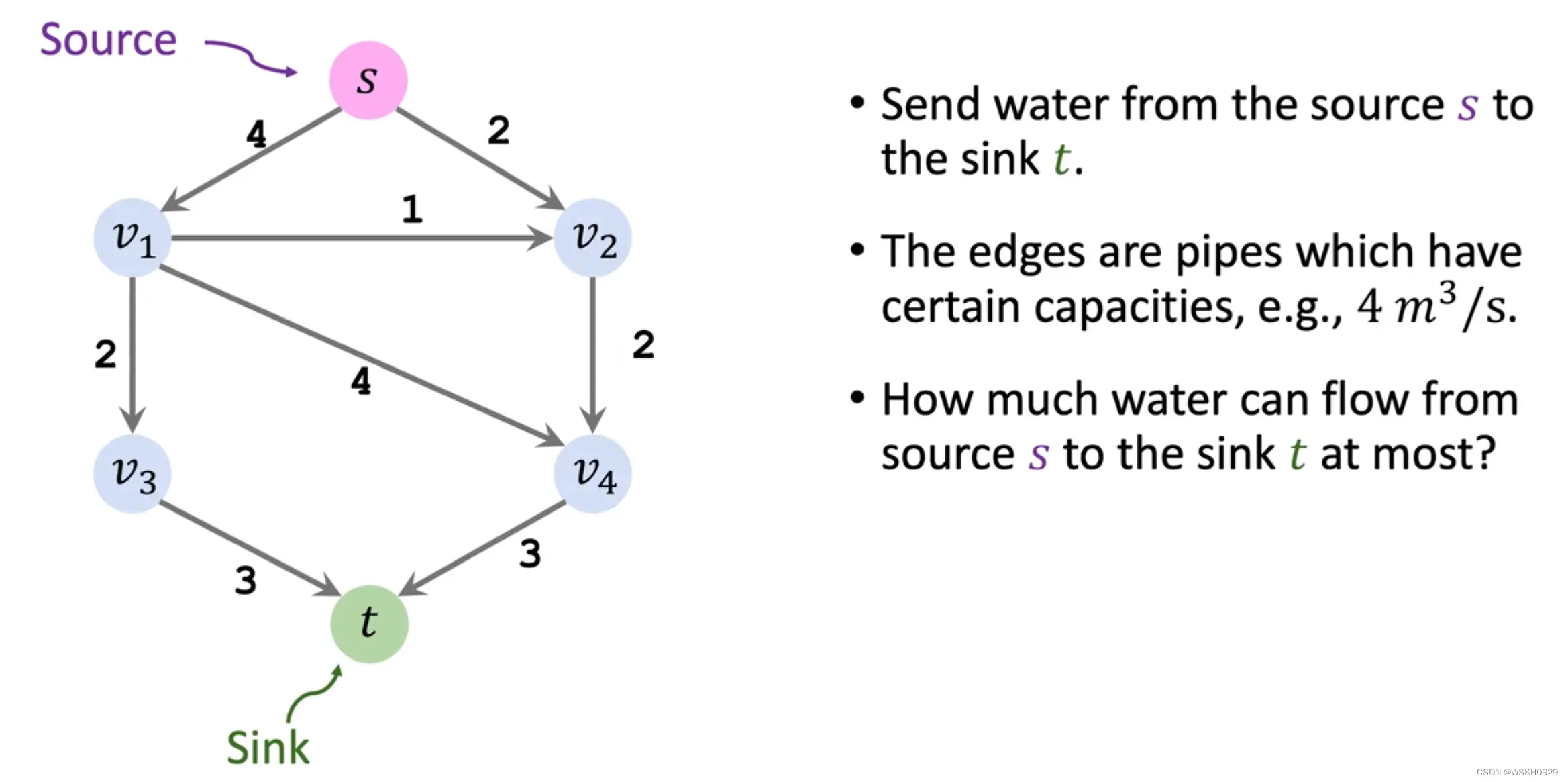
二、Ford-Fulkerson 算法(最坏时间复杂度:O(f×m))
2.1 残存网络
残存网络其实就是用边的剩余容量来表示每条边,如下图所示的残存网络。S->v2这条边上的数字“2”代表这条边剩余可通过容量为2。
实际写代码只用残存网络即可求出最大流
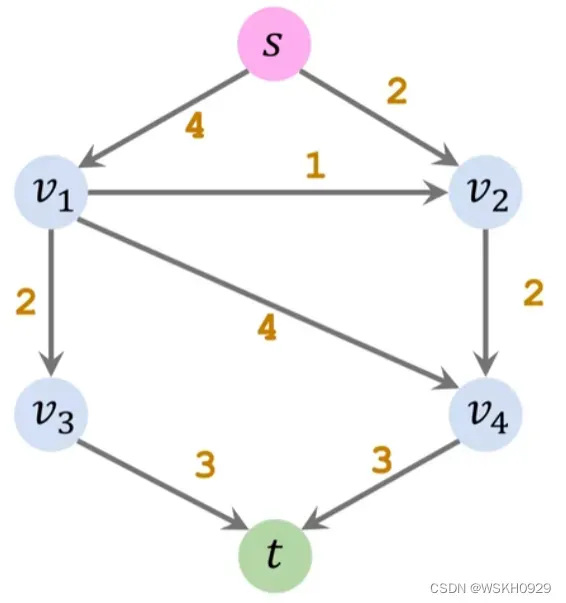
2.2 增广路径
一条能从起点S到达起点T的流量大于0的路径就被称为增广路径,通过增广路径,流量一定会增加。
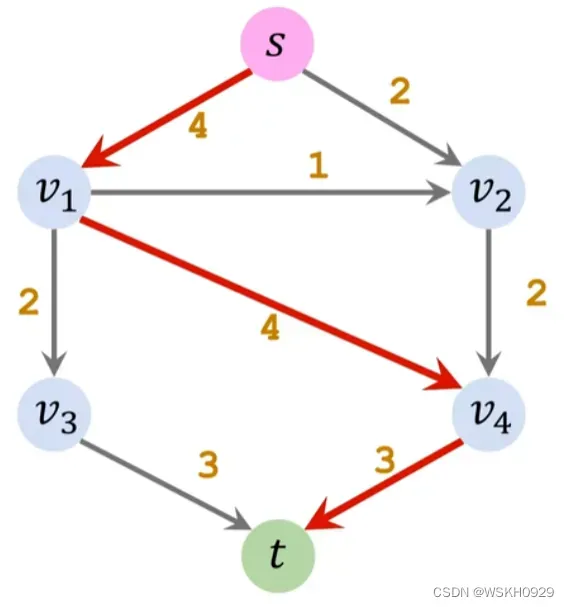
2.3 算法介绍
该算法概况起来,就是在残存网络中不断寻找增广路径,每找到一条增广路径,就递增最大流 ,并更新残存网络,直到残存网络中不存在增广路径,则此时f即为最终的最大流。
Ford-Fulkerson 算法是通过 DFS(深度优先遍历)的方式在当前残存网络中寻找增广路径的。
根据木桶原理,增广路径的流量等于该路径的边的最小剩余流量。如下图所示的增广路径,它的流量就是3,因为 v4->t 的容量为3

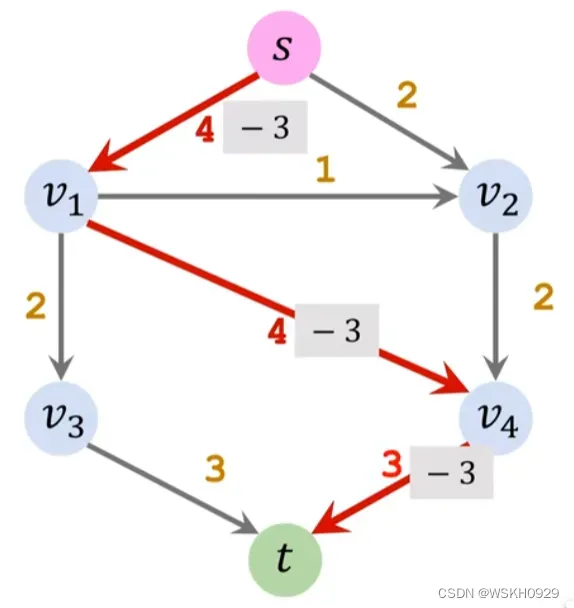

然后对该增广路径的反向边进行更新(反向边在初始化的时候,剩余流量都为0,所以在上面的图中没有画出来,反向边的作用就是让算法可以反悔,从而通过多次迭代,找到最优解),反向边的剩余流量全部加上3
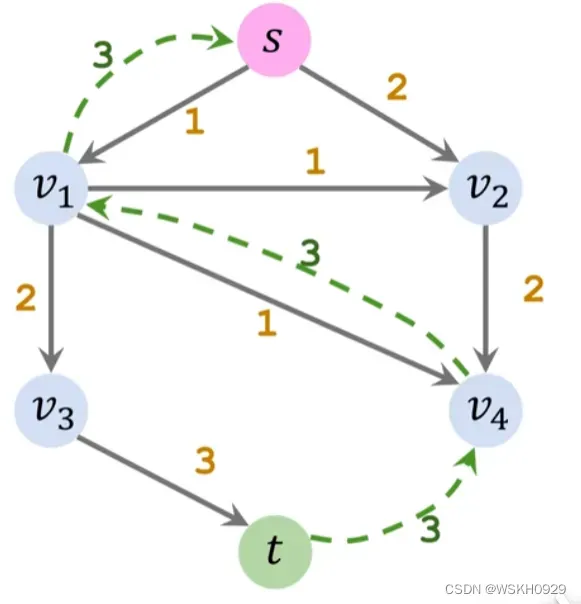
添加反向边是这一算法能够精确求解最大流问题的基础保障
然后重复上述过程,直到找不到增广路径,算法结束
Ford-Fulkerson 算法的整体实现思路如下,其实就是不断从残存网络寻找增广路径的过程
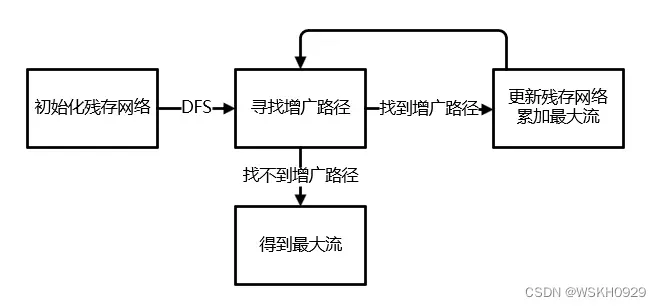
2.4 完整代码
完整代码
# -*- coding: utf-8 -*-#
# Author: WSKH
# Blog: wskh0929.blog.csdn.net
# Time: 2023/2/13 9:45
# Description: Ford Fulkerson 算法求解最大流问题
class Node:
def __init__(self, name, arc_dict):
self.name = name
self.arc_dict = arc_dict
def create_node(name, next_list, flow_list):
arc_dict = {}
for i in range(len(next_list)):
arc_dict[next_list[i]] = flow_list[i]
return Node(name, arc_dict)
def Ford_Fulkerson_Solve(s, e, node_list, name_index_dict):
'''
Ford_Fulkerson 算法核心函数
:param s: 起始节点名称
:param e: 终止节点名称
:param node_list: 节点列表
:param name_index_dict: 节点名字和索引字典
:return: 返回搜索到的所有增广路径及其流值
'''
routes = []
while True:
res = dfs(e, [s], None, node_list, name_index_dict)
if res is None:
return routes
# 追加增广路径到routes
routes.append(res)
# 更新node_list
route, flow = res
for i in range(len(route) - 1):
n1 = node_list[name_index_dict[route[i]]]
n2 = node_list[name_index_dict[route[i + 1]]]
# 正向更新 n1 -> n2 剩余流量减少
if n2.name in n1.arc_dict.keys() and n1.arc_dict[n2.name] is not None:
n1.arc_dict[n2.name] = n1.arc_dict[n2.name] - flow
# 反向更新 n2 -> n1 剩余流量增加
if n1.name in n2.arc_dict.keys() and n2.arc_dict[n1.name] is not None:
n2.arc_dict[n1.name] = n2.arc_dict[n1.name] + flow
def dfs(e, cur_route, last_flow, node_list, name_index_dict):
'''
DFS搜索增广路径
:param e: 终点节点名称
:param cur_route: 当前路径
:param last_flow: 上一个节点的流值,用来计算最小流
:param node_list: 节点列表
:param name_index_dict: 节点名字和索引字典
:return: 返回搜索到的增广路径及其流值,如果没找到就返回 None
'''
if cur_route[-1] == e:
return cur_route, last_flow
index = name_index_dict[cur_route[-1]]
for next_node_name in node_list[index].arc_dict.keys():
if next_node_name not in cur_route:
flow = node_list[index].arc_dict[next_node_name]
if flow is None or flow > 0:
cur_route.append(next_node_name)
res = dfs(e, cur_route, min_flow(last_flow, flow), node_list, name_index_dict)
if res is not None:
return res
cur_route.pop(-1)
def min_flow(f1, f2):
'''
求两个流量的较小者
'''
if f1 is None:
return f2
elif f2 is None:
return f1
else:
return min(f1, f2)
if __name__ == '__main__':
# 格式: [节点名, 后继节点的名称, 当前节点到各个后继的流量] (None 代表流量无穷大)
graph = [
["S", ["1", "2", "3"], [None, None, None]],
["1", ["4"], [1]],
["2", ["4", "6"], [1, 1]],
["3", ["5"], [1]],
["4", ["1", "2", "E"], [0, 0, 1]],
["5", ["3", "E"], [0, 1]],
["6", ["2", "E"], [0, 1]],
["E", [], []]
]
name_index_dict = dict()
node_list = []
for i in range(len(graph)):
node_list.append(create_node(graph[i][0], graph[i][1], graph[i][2]))
name_index_dict[graph[i][0]] = i
# 调用算法求解最大流
routes = Ford_Fulkerson_Solve("S", "E", node_list, name_index_dict)
for i, (route, flow) in enumerate(routes):
print(f"Route-{i + 1}: {route} , flow: {flow}")
测试案例
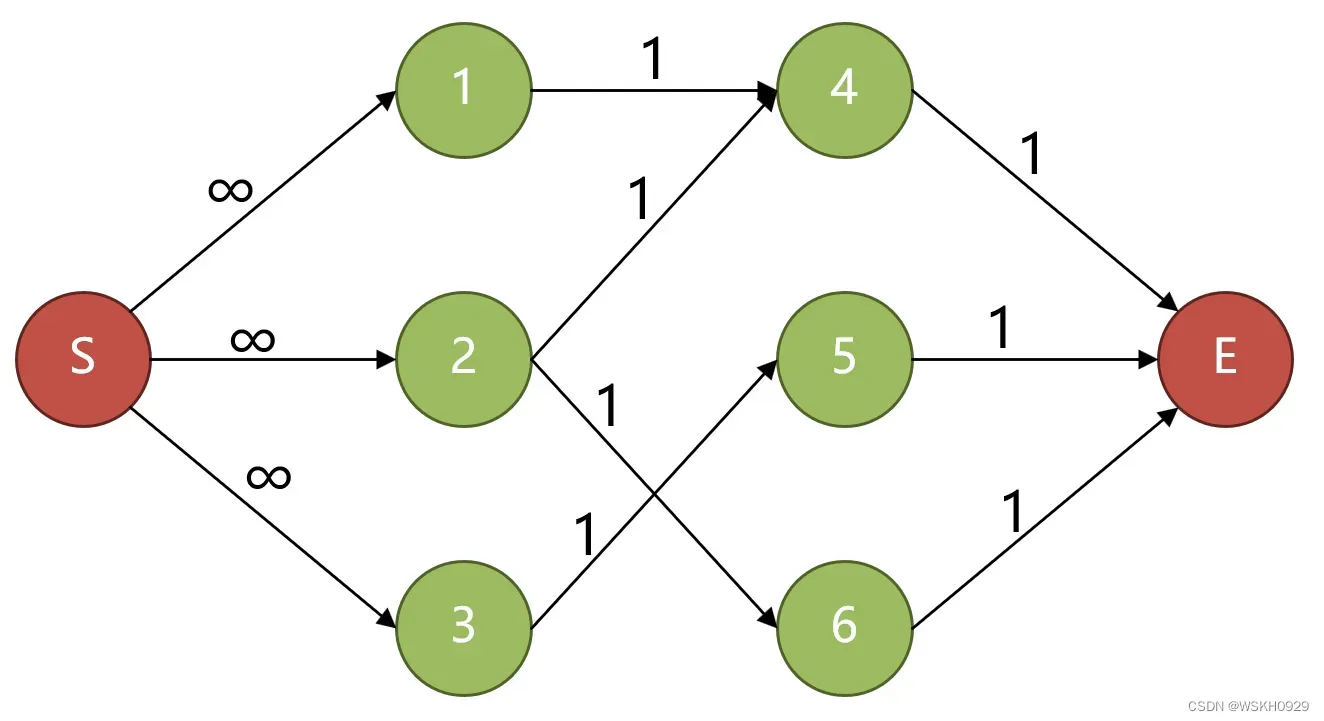
程序输出
Route-1: ['S', '1', '4', 'E'] , flow: 1
Route-2: ['S', '2', '6', 'E'] , flow: 1
Route-3: ['S', '3', '5', 'E'] , flow: 1
三、Edmons-Karp 算法(最坏时间复杂度:O(m×m×n))
3.1 算法介绍
Edmons-Karp 算法比 Ford-Fulkerson 算法晚16年提出,它和 Ford-Fulkerson 算法唯一的区别在于寻找增广路径的方式不同,其余步骤完全一样。Edmons-Karp 算法在寻找增广路的时候是将残存网络看作一个无权图然后求S到T的最短路,这条最短路上的最小剩余流量如果大于0,那么就作为增广路径,进行残存网络的更新。
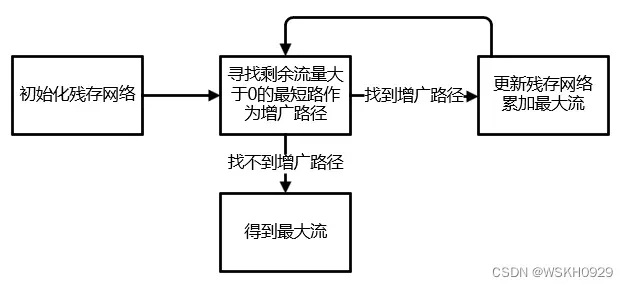
Edmons-Karp 算法贡献在于,它具有比 Ford-Fulkerson 算法更小的时间复杂度,Ford-Fulkerson 算法的时间复杂度受最大流大小影响,而 Edmons-Karp 算法只受节点数量和边的数量的影响
3.2 完整代码
本代码使用 BFS(广度优先搜索) 求最短路,测试案例还是和上面的一样
# -*- coding: utf-8 -*-#
# Author: WSKH
# Blog: wskh0929.blog.csdn.net
# Time: 2023/2/13 11:54
# Description: Edmons Karp 算法求解最大流问题
from queue import PriorityQueue
class Node:
def __init__(self, name, arc_dict):
self.name = name
self.arc_dict = arc_dict
class Label:
def __init__(self, route, last_flow):
self.route = route
self.last_flow = last_flow
def __lt__(self, o):
if len(self.route) == len(o.route):
return 0
else:
return 1 if len(self.route) > len(o.route) else -1
def create_node(name, next_list, flow_list):
arc_dict = {}
for i in range(len(next_list)):
arc_dict[next_list[i]] = flow_list[i]
return Node(name, arc_dict)
def Edmons_Karp_Solve(s, e, node_list, name_index_dict):
'''
Edmons Karp 算法核心函数
:param s: 起始节点名称
:param e: 终止节点名称
:param node_list: 节点列表
:param name_index_dict: 节点名字和索引字典
:return: 返回搜索到的所有增广路径及其流值
'''
routes = []
while True:
res = bfs(s, e, node_list, name_index_dict)
if res is None:
return routes
# 追加增广路径到routes
routes.append([res.route, res.last_flow])
# 更新node_list
route, flow = res.route, res.last_flow
for i in range(len(route) - 1):
n1 = node_list[name_index_dict[route[i]]]
n2 = node_list[name_index_dict[route[i + 1]]]
# 正向更新 n1 -> n2 剩余流量减少
if n2.name in n1.arc_dict.keys() and n1.arc_dict[n2.name] is not None:
n1.arc_dict[n2.name] = n1.arc_dict[n2.name] - flow
# 反向更新 n2 -> n1 剩余流量增加
if n1.name in n2.arc_dict.keys() and n2.arc_dict[n1.name] is not None:
n2.arc_dict[n1.name] = n2.arc_dict[n1.name] + flow
def bfs(s, e, node_list, name_index_dict):
queue = PriorityQueue()
queue.put(Label([s], None))
while queue.empty() is False:
res = queue.get()
index = name_index_dict[res.route[-1]]
for next_node_name in node_list[index].arc_dict.keys():
if next_node_name not in res.route:
flow = node_list[index].arc_dict[next_node_name]
if flow is None or flow > 0:
route = res.route.copy()
route.append(next_node_name)
if next_node_name == e:
return Label(route, min_flow(res.last_flow, flow))
queue.put(Label(route, min_flow(res.last_flow, flow)))
def min_flow(f1, f2):
'''
求两个流量的较小者
'''
if f1 is None:
return f2
elif f2 is None:
return f1
else:
return min(f1, f2)
if __name__ == '__main__':
# 格式: [节点名, 后继节点的名称, 当前节点到各个后继的流量] (None 代表流量无穷大)
graph = [
["S", ["1", "2", "3"], [None, None, None]],
["1", ["4"], [1]],
["2", ["4", "6"], [1, 1]],
["3", ["5"], [1]],
["4", ["1", "2", "E"], [0, 0, 1]],
["5", ["3", "E"], [0, 1]],
["6", ["2", "E"], [0, 1]],
["E", [], []]
]
name_index_dict = dict()
node_list = []
for i in range(len(graph)):
node_list.append(create_node(graph[i][0], graph[i][1], graph[i][2]))
name_index_dict[graph[i][0]] = i
# 调用算法求解最大流
routes = Edmons_Karp_Solve("S", "E", node_list, name_index_dict)
for i, (route, flow) in enumerate(routes):
print(f"Route-{i + 1}: {route} , flow: {flow}")
程序输出
Route-1: ['S', '1', '4', 'E'] , flow: 1
Route-2: ['S', '2', '6', 'E'] , flow: 1
Route-3: ['S', '3', '5', 'E'] , flow: 1
四、Dinic 算法(最坏时间复杂度:O(m×n×n))
由于边的数量 m 通常远远大于节点数量 n,所以通常情况下 Dinic 算法比 Edmons-Karp 算法更快。而且 Dinic 算法发表时间比 Edmons-Karp 算法还要早两年。
为了更好的讲解 Dinic 算法,下面先介绍一个重要的概念 Level Graph
4.1 Level Graph
Level Graph 是原图的一个子图,保留了原图中的所有节点和一部分边,下面图解 Level Graph 的构造过程
首先,将 S 作为 Level Graph 的第零层
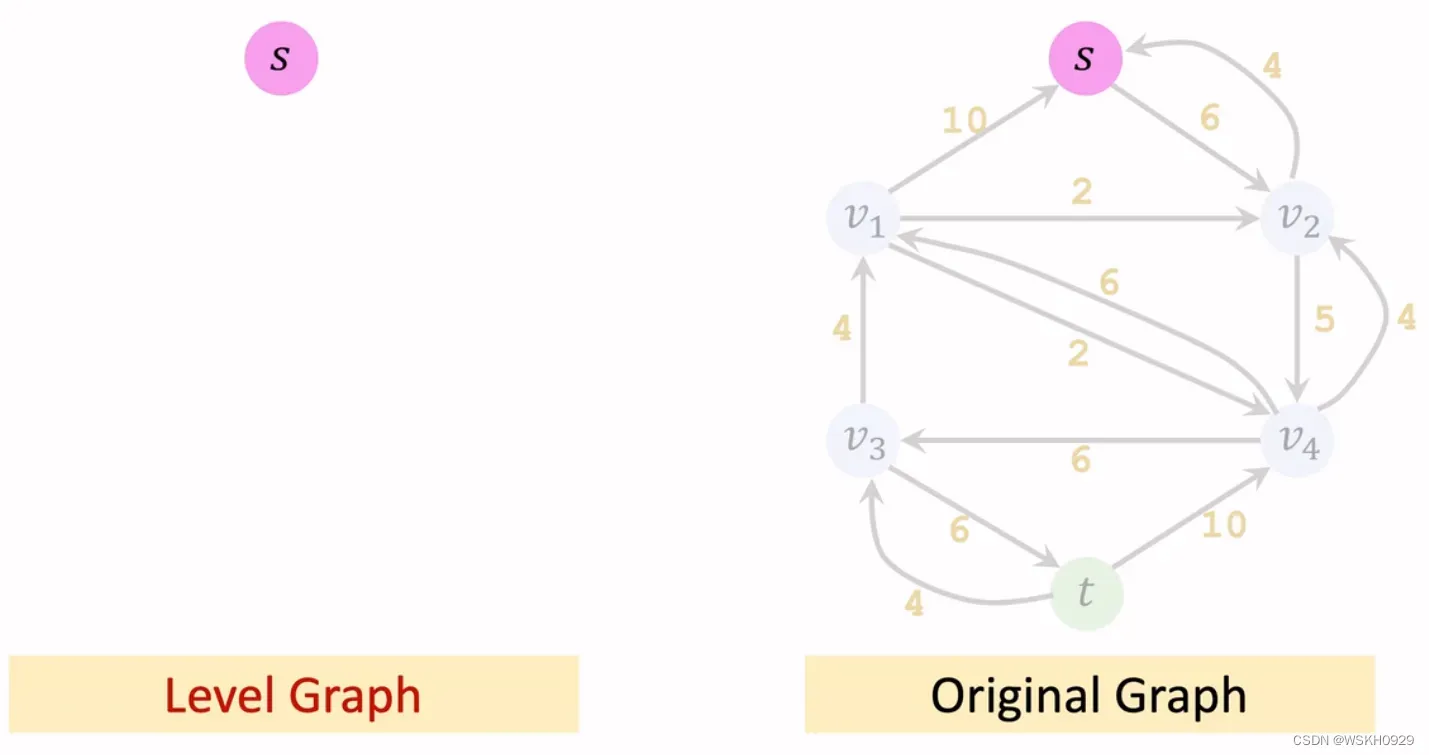
然后,从 S 出发,可以到达的点有 v2,将 v2 加入 Level Graph,记作第一层 ,保留第零层到第一层的边
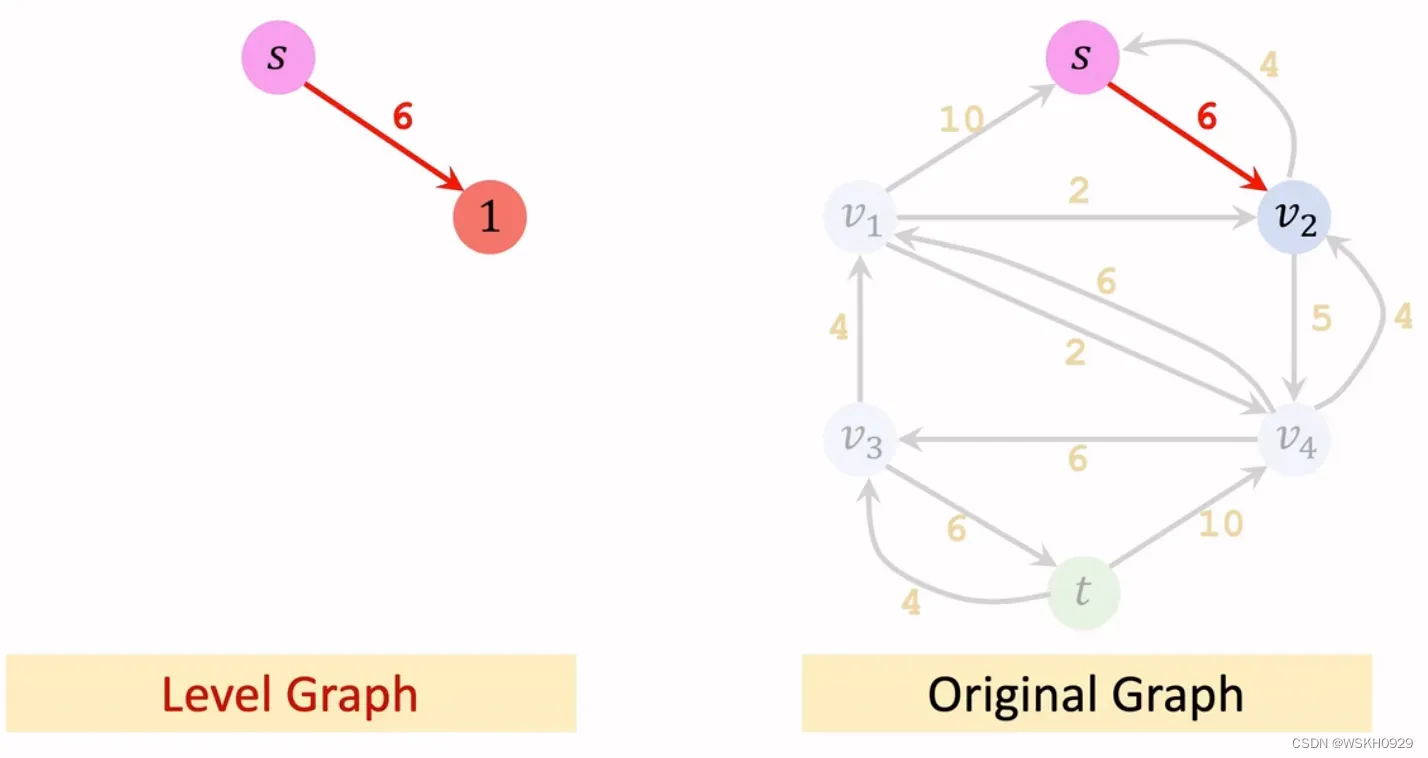
看一下右边的原图,从第一层可以到达的节点有 S 和 v4,由于 S 已经在 Level Graph 中了,所以不考虑。将 v4 加入 Level Graph,记作第二层,保留第一层到第二层的边。

看一下右边的原图,从第二层可以到达的节点有 v1、v2和v3,由于 v2 已经在 Level Graph中了,所以只考虑 v1和v3,将它们加入 Level Graph,记作第三层,保留第二层到第三层的边

看一下右边的原图,从第三层可以到达所有节点,由于目前只剩下节点 t 没有加入 Level Graph,所以将 t 加入 Level Graph,记作第四层,保留第三层到第四层的边。

至此,原图的 Level Graph 构造完毕!Level Graph 中节点的层数代表着从起点到达该起点所需要的最少步数(其实就是无权图下的最短路),这么看来,Dinic 算法其实结合了 Ford-Filkerson 和 Edmons-Karp 两个算法的思想呀!
4.2 算法介绍
介绍完 Level Graph,下面开始正式介绍 Dinic 算法!
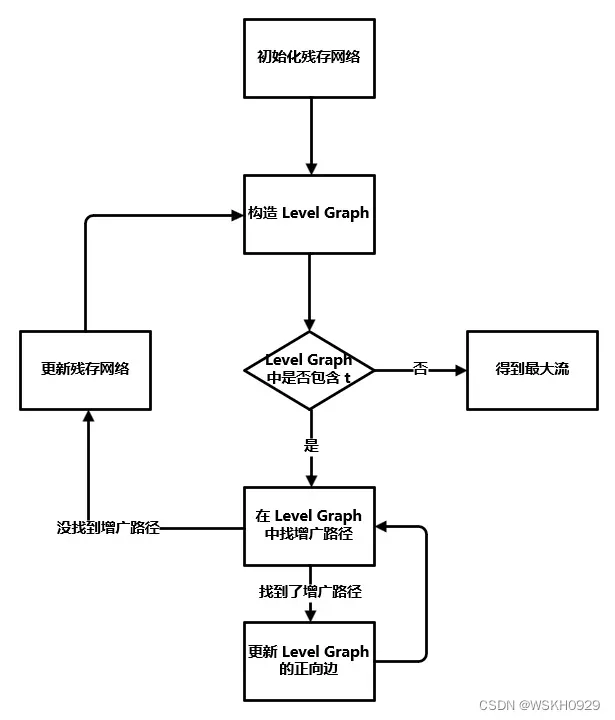
4.3 完整代码
# -*- coding: utf-8 -*-#
# Author: WSKH
# Blog: wskh0929.blog.csdn.net
# Time: 2023/2/13 19:26
# Description: Dinic 算法求解最大流问题
import numpy as np
class Node:
def __init__(self, name, arc_dict):
self.name = name
self.arc_dict = arc_dict
def create_node(name, next_list, flow_list):
arc_dict = {}
for i in range(len(next_list)):
arc_dict[next_list[i]] = flow_list[i]
return Node(name, arc_dict)
def create_level_graph(s, e, node_list, name_index_dict):
level_graph = np.zeros((len(node_list), len(node_list))).tolist()
cur_layer = [s]
all_node = set()
all_node.add(s)
next_layer = set()
while len(cur_layer) > 0:
for node_name in cur_layer:
node = node_list[name_index_dict[node_name]]
for key in node.arc_dict.keys():
if key not in all_node and (node.arc_dict[key] is None or node.arc_dict[key] > 0):
level_graph[name_index_dict[node_name]][name_index_dict[key]] = node.arc_dict[key]
next_layer.add(key)
all_node.add(key)
cur_layer = list(next_layer)
next_layer = set()
return level_graph if e in all_node else None
def Dinic_Solve(s, e, node_list, name_index_dict):
routes = []
s_index = name_index_dict[s]
e_index = name_index_dict[e]
level_graph = create_level_graph(s, e, node_list, name_index_dict)
while level_graph is not None:
res_list = []
while True:
res = dfs(e_index, [s_index], None, level_graph)
if res is None:
break
# 更新 level graph
route, flow = res
for i in range(len(route) - 1):
if level_graph[route[i]][route[i + 1]] is not None:
level_graph[route[i]][route[i + 1]] -= flow
# 追加记录增广路径
res_list.append(res)
routes.append([[node_list[n].name for n in res[0]], res[1]])
# 更新残存网络
for res in res_list:
update(res, node_list)
# 重新构造 level graph
level_graph = create_level_graph(s, e, node_list, name_index_dict)
return routes
def update(res, node_list):
route, flow = res
for i in range(len(route) - 1):
n1 = node_list[route[i]]
n2 = node_list[route[i + 1]]
# 正向更新 n1 -> n2 剩余流量减少
if n2.name in n1.arc_dict.keys() and n1.arc_dict[n2.name] is not None:
n1.arc_dict[n2.name] = n1.arc_dict[n2.name] - flow
# 反向更新 n2 -> n1 剩余流量增加
if n1.name in n2.arc_dict.keys() and n2.arc_dict[n1.name] is not None:
n2.arc_dict[n1.name] = n2.arc_dict[n1.name] + flow
def dfs(e_index, cur_route, last_flow, level_graph):
if cur_route[-1] == e_index:
return cur_route, last_flow
for next_node in range(len(level_graph)):
if next_node not in cur_route:
if level_graph[cur_route[-1]][next_node] is None or level_graph[cur_route[-1]][next_node] > 0:
flow = min_flow(level_graph[cur_route[-1]][next_node], last_flow)
cur_route.append(next_node)
res = dfs(e_index, cur_route, flow, level_graph)
if res is not None:
return res
cur_route.pop(-1)
def min_flow(f1, f2):
'''
求两个流量的较小者
'''
if f1 is None:
return f2
elif f2 is None:
return f1
else:
return min(f1, f2)
if __name__ == '__main__':
# 格式: [节点名, 后继节点的名称, 当前节点到各个后继的流量] (None 代表流量无穷大)
graph = [
["S", ["1", "2", "3"], [None, None, None]],
["1", ["4"], [1]],
["2", ["4", "6"], [1, 1]],
["3", ["5"], [1]],
["4", ["1", "2", "E"], [0, 0, 1]],
["5", ["3", "E"], [0, 1]],
["6", ["2", "E"], [0, 1]],
["E", [], []]
]
name_index_dict = dict()
node_list = []
for i in range(len(graph)):
node_list.append(create_node(graph[i][0], graph[i][1], graph[i][2]))
name_index_dict[graph[i][0]] = i
# 调用算法求解最大流
routes = Dinic_Solve("S", "E", node_list, name_index_dict)
for i, (route, flow) in enumerate(routes):
print(f"Route-{i + 1}: {route} , flow: {flow}")
程序输出
Route-1: ['S', '3', '5', 'E'] , flow: 1
Route-2: ['S', '1', '4', 'E'] , flow: 1
Route-3: ['S', '2', '6', 'E'] , flow: 1
五、三种算法的性能测试
本节测试所用的案例是随机案例,如下图所示,根据指定的 m 和 n,构造一个中间有两层节点的网络图

5.1 测试1
在测试1中,固定 m = 10,n 从 2 开始以 1 的步长一直自增到 20

5.2 测试2
在测试2中,固定 n = 10,m 从 2 开始以 1 的步长一直自增到 20
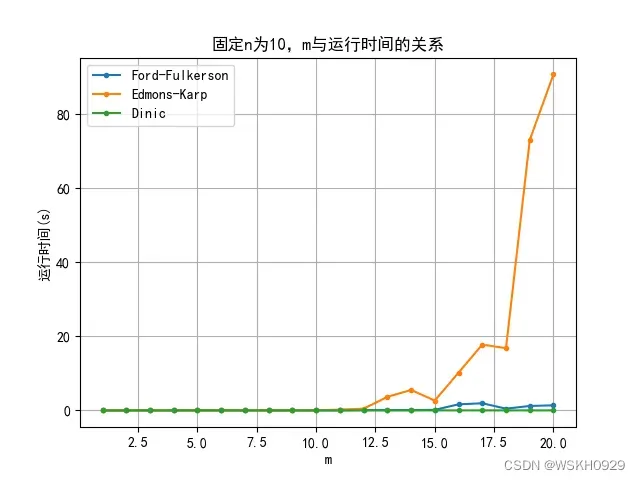
5.3 测试部分完整代码
# -*- coding: utf-8 -*-#
# Author: WSKH
# Blog: wskh0929.blog.csdn.net
# Time: 2023/2/13 15:23
# Description:
import time
import random
from matplotlib import pyplot as plt
plt.rcParams['font.sans-serif'] = ['SimHei'] # 用来正常显示中文标签
plt.rcParams['axes.unicode_minus'] = False # 用来正常显示负号 #有中文出现的情况,需要u'内容'
from EdmonsKarp import Edmons_Karp_Solve
from FordFulkerson import Ford_Fulkerson_Solve
from Dinic import Dinic_Solve
from copy import deepcopy
class Node:
def __init__(self, name, arc_dict):
self.name = name
self.arc_dict = arc_dict
def create_node(name, next_list, flow_list):
arc_dict = {}
for i in range(len(next_list)):
arc_dict[next_list[i]] = flow_list[i]
return Node(name, arc_dict)
def create_instance(m, n, seed=666):
random.seed(seed)
S = "S"
E = "E"
node_list = []
name_index_dict = {}
name_index_dict["S"] = 0
name_index_dict["E"] = m + n + 1
for i in range(m + n):
name_index_dict[str(i + 1)] = i + 1
# 构造起点
node_list.append(create_node("S", [str(i + 1) for i in range(m)], [random.randint(800, 1200) for _ in range(m)]))
# 构造第一层
for i in range(m):
node_list.append(
create_node(str(i + 1), [str(i + j + 2) for j in range(n)], [random.randint(800, 1200) for _ in range(n)]))
# 构造第二层
for i in range(n):
next_list = ["E"]
flow_list = [random.randint(800, 1200)]
for j in range(m):
next_list.append(str(j + 1))
flow_list.append(0)
node_list.append(create_node(str(m + i + 1), next_list, flow_list))
# 构造终点
node_list.append(create_node("E", [], []))
return S, E, node_list, name_index_dict
def test1():
m = 10
n_arr = [i for i in range(1, 21, 1)]
time_dict = {
"Ford-Fulkerson": [],
"Edmons-Karp": [],
"Dinic": []
}
for n in n_arr:
instance = create_instance(m, n)
S, E, node_list, name_index_dict = deepcopy(instance)
start_time = time.time()
Ford_Fulkerson_Solve(S, E, node_list, name_index_dict)
time_dict["Ford-Fulkerson"].append(time.time() - start_time)
S, E, node_list, name_index_dict = deepcopy(instance)
start_time = time.time()
Edmons_Karp_Solve(S, E, node_list, name_index_dict)
time_dict["Edmons-Karp"].append(time.time() - start_time)
S, E, node_list, name_index_dict = deepcopy(instance)
start_time = time.time()
Dinic_Solve(S, E, node_list, name_index_dict)
time_dict["Dinic"].append(time.time() - start_time)
plot(time_dict, n_arr, "固定m为10,n与运行时间的关系", "n")
def test2():
n = 10
m_arr = [i for i in range(1, 21, 1)]
time_dict = {
"Ford-Fulkerson": [],
"Edmons-Karp": [],
"Dinic": []
}
for m in m_arr:
print(m)
instance = create_instance(m, n)
S, E, node_list, name_index_dict = deepcopy(instance)
start_time = time.time()
Ford_Fulkerson_Solve(S, E, node_list, name_index_dict)
time_dict["Ford-Fulkerson"].append(time.time() - start_time)
S, E, node_list, name_index_dict = deepcopy(instance)
start_time = time.time()
Edmons_Karp_Solve(S, E, node_list, name_index_dict)
time_dict["Edmons-Karp"].append(time.time() - start_time)
S, E, node_list, name_index_dict = deepcopy(instance)
start_time = time.time()
Dinic_Solve(S, E, node_list, name_index_dict)
time_dict["Dinic"].append(time.time() - start_time)
plot(time_dict, m_arr, "固定n为10,m与运行时间的关系", "m")
def plot(time_dict, arr, title, x_label):
for key in time_dict.keys():
plt.plot(arr, time_dict[key], marker=".", label=key)
plt.legend()
plt.xlabel(x_label)
plt.ylabel("运行时间(s)")
plt.title(title)
plt.grid(True)
plt.show()
if __name__ == '__main__':
# test1()
test2()
5.4 结论(仅供参考)
- 当点的数量远大于边的数量时,采用 Edmons-Karp 算法
- 否则采用 Ford-Filkerson 算法和 Dinic 算法(在我的测试中,这两种该算法性能差不多,不过 Dinic 算法看起来更加稳健一些,当然有条件的话最好都尝试一下)
文章出处登录后可见!
